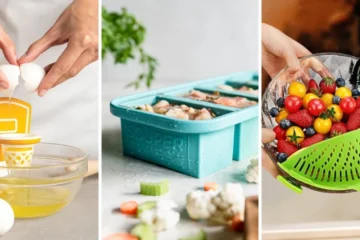Growing in a tiny garden space can be just as enjoyable and fulfilling as gardening in a huge one. More food is being grown by urban gardeners these days, often in spaces smaller than 100 square feet. Herbs and vegetables grow well on balconies, patios, and even interior windowsills.
You can grow almost anything in a container. Here are 9 of the best herbs and veggies to produce in a small garden if you’re wondering what to plant to get the highest yield in a limited space.
1. Shallots:
Shallots should be about 4-6 inches apart, with rows spaced 18 inches apart. Plant the bulb with its root end facing downward and its top one inch below the ground. Planting bulbs too deeply results in elongated bulbs that are poorly stored.
2. Carrots:
Create a trench that is only 1/4 inch deep and uniformly sow the seeds. Maintain moisture levels for seedlings to sprout. Arrange the rows around 12″ apart. As the initial leaves appear, space them out to 1″ apart; as the actual leaves appear, space them out to 3″.
3. Cherry Tomatoes:
Use expanding seed starting soil pods to sow tomato seeds approximately eight weeks before your area’s last frost date. If they receive fewer than 12 to 14 hours of light every day, seedlings will become spindly; endeavor to keep them in a warm, sunny spot.
Transfer seedlings to a deeper pot (3–4″ deep) once they have four leaves, and then again when they are 8–10 inches tall. Every time, remove the lower leaves and position the highest leaves just above the soil line.
When the stem is 8 to 10 inches tall above the dirt, transplant it into the garden. Before transferring them outside, make sure they have hardened off. The tomato plants need up to ten days to adjust to temperature changes outside.
4. Runner Beans:
Three six-foot poles should be positioned in the ground like a marquee and tied together at the top. Space the pole groups apart by three to four feet. Plant six to eight seeds in each of the hills you create at the base of each pole, enriching them with compost or well-rotted manure.
Reduce to three plants per pole after the appearance of the second pair of real leaves. Pole beans can yield for the entire summer if they are regularly harvested.
5. Garlic:
Split the cloves from the bulb, being careful to preserve the papery husk on each clove. Make sure the soil has enough organic content and is well-drained. Give your plant full sun.
Plants should be spaced 4 inches apart and 2 inches deep, with the pointed end leading up and the wide end down. Springtime will bring the emergence of buds.
6. Kale:
Rows of kale should be spaced 18 inches to 2 feet apart. Plants should be thinned to a distance of 10 inches from one another when they are 3 inches or taller. The thinned vegetables can be added to salads or cooked.
7. Basil:
Plant your basil 12 inches apart, if possible. Basil plants grow beautifully in containers as long as the leaves are harvested young.
8. Lettuce:
Seed should be sown thinly in rows spaced one foot apart. For leaf kinds, thin plants to 2–3 inches apart, then thin again by removing every other plant when half-grown. Thickly-developed plants will be encouraged by this.
Space rows 18 inches apart and plants 8–10 inches apart for head, Bibb, and cos varieties. Smaller heads are produced via closer spacing, which might be better for small families.
9. Beets:
Plant seeds 12–18 inches apart in rows that are 1/2 inch deep. The beet seed is a little ball made up of numerous tiny seeds. Seed should be used sparingly because many plants sprout where it is sown.
Plant thinning to a distance of 1 1/2 inches when seedlings are 4–6 inches tall. (You may cook them like spinach or use them in salads.) Next, pluck every other beet as they reach about one inch in diameter so that bigger beets can grow.
Let’s Plant your Own Vegetables Together
Get all the gardening equipment and materials you need for a beautiful, healthy garden without breaking the bank.
Shop for all of your seasonal gardening needs at a very affordable price by selecting from the many gardening deals, coupon codes, and available promotional offers.
Olle Gardens
Olle doesn’t think starting a more eco-friendly and health-conscious lifestyle has to mean sacrificing elegance and simplicity. You and your family will have an amazing time gardening with the Olle brand product line.
Homegrown Garden
For those who love to garden, Homegrown Garden is a company that provides kits and seeds. Their mission is to support individuals in their gardening initiatives by offering top-notch, highly germination seeds that gardeners will love.
VEGEGA
VEGEGA is a company that specializes in producing raised garden beds and garden boxes that are modular. ZAM Steel is a type of coated steel sheet that is more resistant to corrosion and is perfect for garden beds.
Conclusion
To sum up, raising vegetables on your own is a fulfilling and delightful activity that offers many advantages for both the environment and your health. Starting your own vegetable garden and enjoying wonderful, fresh vegetables all year long is possible if you follow these ideas and strategies.
Do not hesitate to try new things and experiment because gardening is a learning process. Have fun with your garden!




